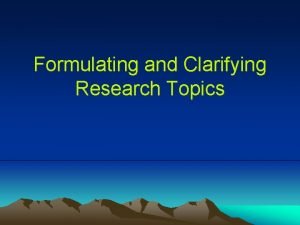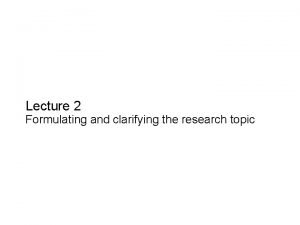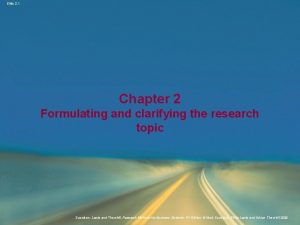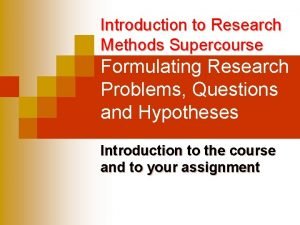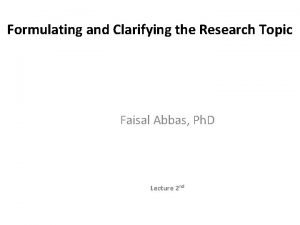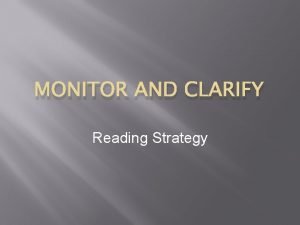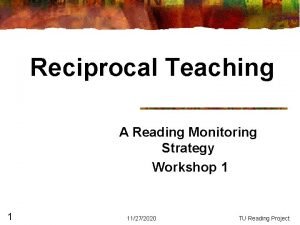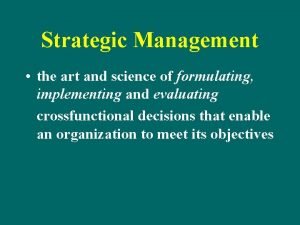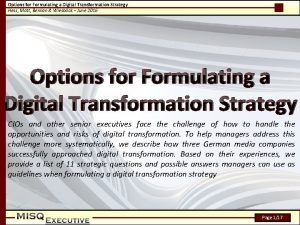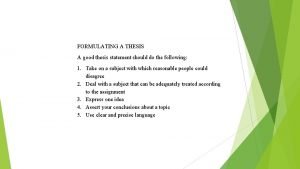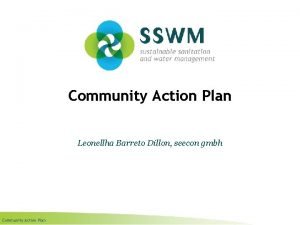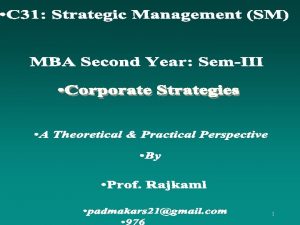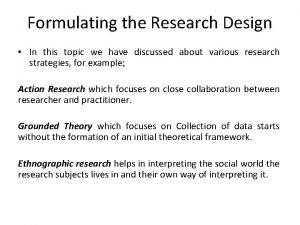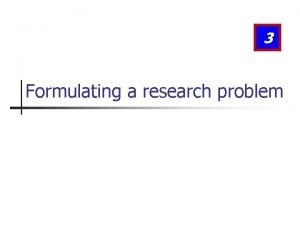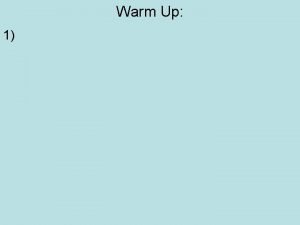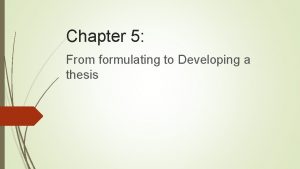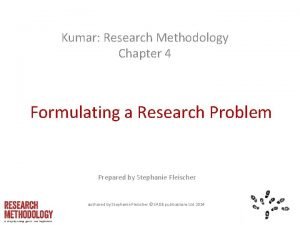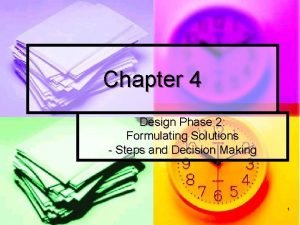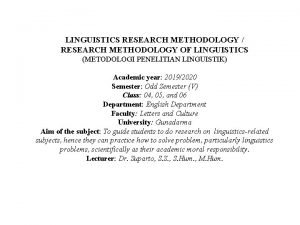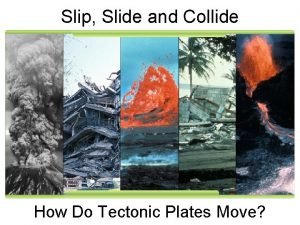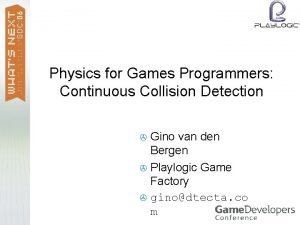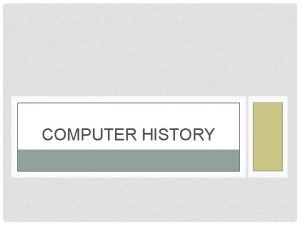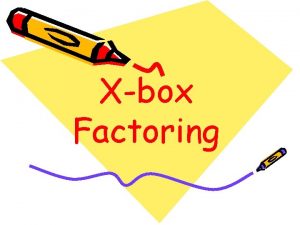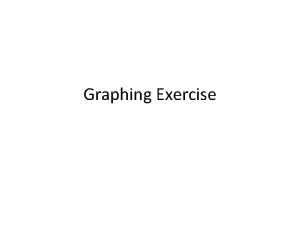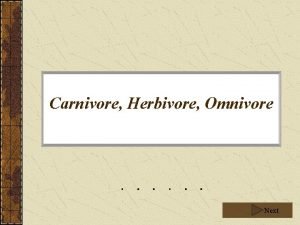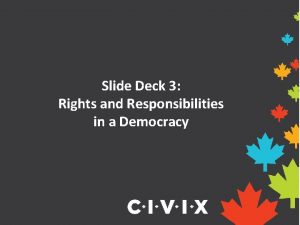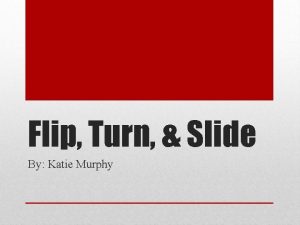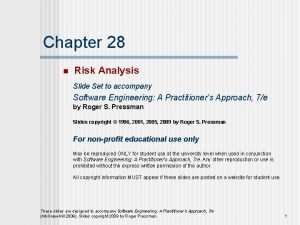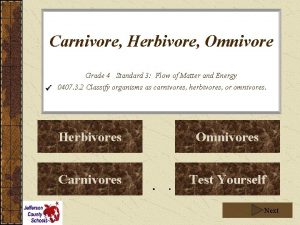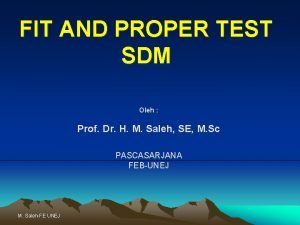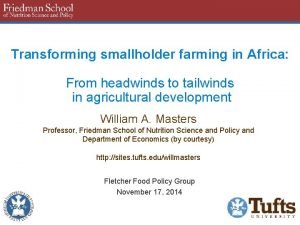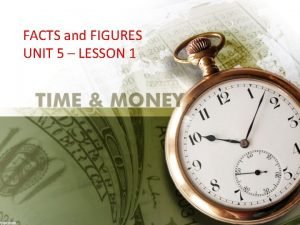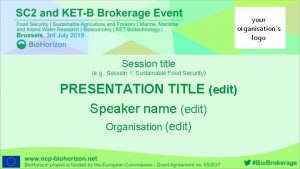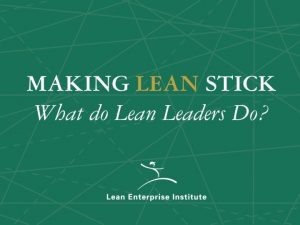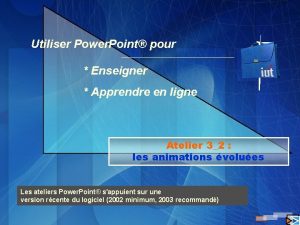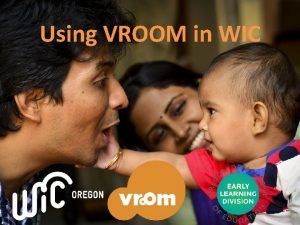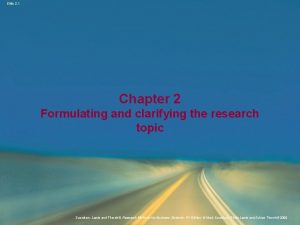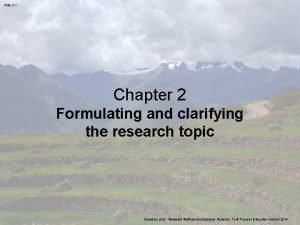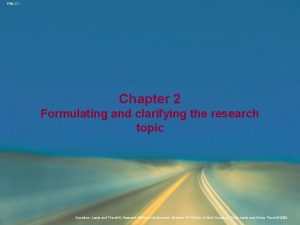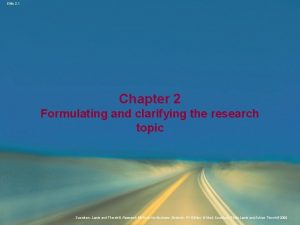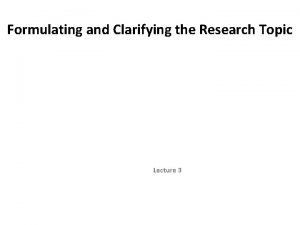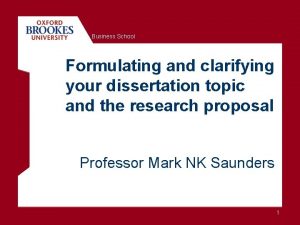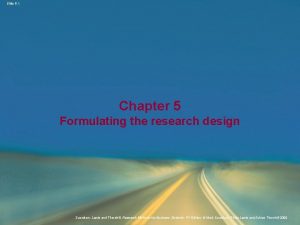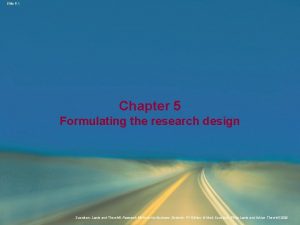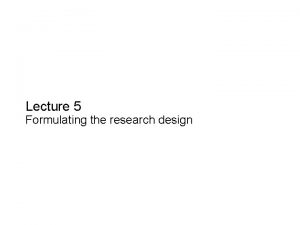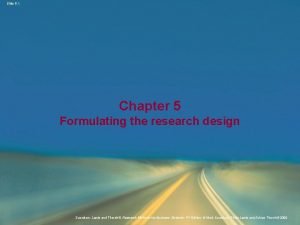Slide 2 1 Ch 2 Formulating and Clarifying















































- Slides: 47

Slide 2. 1 + Ch 2: Formulating and Clarifying the Research Topic Saunders, Lewis and Thornhill, Research Methods for Business Students , 5 th Edition, © Mark Saunders, Philip Lewis and Adrian Thornhill 2009

Slide 2. 2 + Learning outcomes n By the end of this chapter you should be able to: n Generate ideas that will help in the choice of a suitable research topic; n Identify the attributes of a good research topic; n Turn research ideas into a research project that has clear research question (s) and objectives; n Draft a research proposal Saunders, Lewis and Thornhill, Research Methods for Business Students , 5 th Edition, © Mark Saunders, Philip Lewis and Adrian Thornhill 2009

Slide 2. 3 + Alice in wonderland: n Alice: Will you tell me, please, which way I ought to walk from here? n The Cheshire Cat: That depends a good deal on where you want to go n Alice: I don’t much care where n The Cheshire Cat: Then it doesn’t matter which way you will walk! (Alice’s Adventure in the Wonderland) Saunders, Lewis and Thornhill, Research Methods for Business Students , 5 th Edition, © Mark Saunders, Philip Lewis and Adrian Thornhill 2009

Slide 2. 4 Relationship Among the Stages in the Research Process Formulate Problem Determine Research Design Data Collection Method and Forms Design Sample and Collect Data Analyze and Interpret the Data Prepare the Research Report Saunders, Lewis and Thornhill, Research Methods for Business Students , 5 th Edition, © Mark Saunders, Philip Lewis and Adrian Thornhill 2009

Slide 2. 5 Questions That Need Addressing at the Various Stages of the Research Process Stage in the Process Typical Questions Formulate problem What is the purpose of the study--to solve a problem? Identify an opportunity? Is additional background information necessary? What information is needed to make the decision? How will the information be utilized? Should research be conducted? Determine research design How much is already known? Can a hypothesis be formulated? What types of questions need to be answered? What type of study will best address the research questions? Determine data collection method and forms Can existing data be used to advantage? What is to be measured? How? What is the source of the data? Can objective answers be obtained by asking people? How should people be questioned? Should the questionnaires be administered in person, over the phone, or through the mail? Should electronic or mechanical means be used to make the observations? What specific behaviors should the observers record? Should structure or unstructured items be used to collect the data? Should the purpose of the study be made known to the respondents? Should rating scales be used in the questionnaire? Saunders, Lewis and Thornhill, Research Methods for Business Students , 5 th Edition, © Mark Saunders, Philip Lewis and Adrian Thornhill 2009

Slide 2. 6 Questions That Need Addressing at the Various Stages of the Research Process Stage in the Process Typical Questions Design sample and collect the data Who is the target population? Is a list of population elements available? Is a sample necessary? Is a probability sample desirable? How large should the sample be? How should the sample be selected? Who will gather the data? How long will the data gathering take? How much supervision is needed? What operational procedures will be followed? What methods will be used to ensure the quality of the data collected? Analyze and interpret the data Who will handle the editing of the data? How will the data be coded? Who will supervise the coding? Will computer or hand tabulation be utilized? What tabulations are called for? What analysis techniques will be used? Prepare the research report Who will read the report? What is their technical level of sophistication? Are managerial recommendations called for? What will be the format of the written report? Is an oral report necessary? How should the oral report be structured? Saunders, Lewis and Thornhill, Research Methods for Business Students , 5 th Edition, © Mark Saunders, Philip Lewis and Adrian Thornhill 2009

Slide 2. 7 General Project Proposal + Project Title: Research on Your Consumers by bidding Marketing Research Firm n n n n Purpose of Research Project State goals and objectives Describe scope of project Spell out specific questions to be answered Address possible limitations due to time or budget constraints n n n n Marketing Problem Brief description of general problem; reason for conducting research Sum up preliminary discussions between researcher and manager; demonstrate knowledge of situation & particular information needs Data Sources & Methodology Describe the secondary data to be used Describe primary data to be gathered Keep methods descriptions nontechnical Describe sample and proposed size Include draft of questionnaire or focus group moderator outline Time and Personnel Provide time estimates for each phase of the research Specify personnel required & rates of pay Calculate nonpersonnel costs Saunders, Lewis and Thornhill, Research Methods for Business Students , 5 th Edition, © Mark Saunders, Philip Lewis and Adrian Thornhill 2009

Slide 2. 8 + Formulating and clarifying your research topic The important steps n Identifying the attributes of a good research topic n Generating ideas that help you select a suitable topic n Turning ideas into clear research questions and objectives n Writing your research proposal Saunders, Lewis and Thornhill, Research Methods for Business Students , 5 th Edition, © Mark Saunders, Philip Lewis and Adrian Thornhill 2009

Slide 2. 9 + Attributes of a good research topic (1) Capability: is it feasible? n Are n Do you fascinated by the topic? you have the necessary research skills? n Can you complete the project in the time available? n Will the research still be current when you finish? n Do you have sufficient financial and other resources? n Will you be able to gain access to data? Saunders, Lewis and Thornhill, Research Methods for Business Students , 5 th Edition, © Mark Saunders, Philip Lewis and Adrian Thornhill 2009

Slide 2. 10 + Attributes of a good research topic (2) Appropriateness: is it worthwhile? n Will the examining institute's standards be met? n Does the topic contain issues with clear links to theory? n Are the research questions and objectives clearly stated? n Will the proposed research provide fresh insights into the topic? n Are the findings likely to be symmetrical? n Does the research topic match your career goals? Saunders, Lewis and Thornhill, Research Methods for Business Students , 5 th Edition, © Mark Saunders, Philip Lewis and Adrian Thornhill 2009

Slide 2. 11 + Attributes of a good research topic (3) And - (if relevant) Does the topic relate clearly to an idea you were given - possibly by your organisation ? Saunders, Lewis and Thornhill, Research Methods for Business Students , 5 th Edition, © Mark Saunders, Philip Lewis and Adrian Thornhill 2009

Slide 2. 12 + Generating research ideas Useful Techniques Rational thinking Creative thinking Searching the literature Scanning the media Brainstorming Relevance Trees Exploring past projects Discussion Keeping an ideas notebook Saunders, Lewis and Thornhill, Research Methods for Business Students , 5 th Edition, © Mark Saunders, Philip Lewis and Adrian Thornhill 2009

Slide 2. 13 + Rational thinking n Examining your own strengths and interests n Looking at past project titles n Discussion n Searching the literature n Scanning the media Saunders, Lewis and Thornhill, Research Methods for Business Students , 5 th Edition, © Mark Saunders, Philip Lewis and Adrian Thornhill 2009

Slide 2. 14 + Creative thinking n Keeping a notebook of ideas n Exploring personal preferences using past projects n Relevance trees n Brainstorming Saunders, Lewis and Thornhill, Research Methods for Business Students , 5 th Edition, © Mark Saunders, Philip Lewis and Adrian Thornhill 2009

Slide 2. 15 + Rational thinking and creative thinking n These techniques will generate possible project one of two outcomes: n One or more possible project ideas that you might undertake; n Absolute panic because nothing in which you are interested or which seems suitable has come to mind. Saunders, Lewis and Thornhill, Research Methods for Business Students , 5 th Edition, © Mark Saunders, Philip Lewis and Adrian Thornhill 2009

Slide 2. 16 + Examining own strengths and interests n Having some academic knowledge n Look at those assignments for which you have received good grade. n You may, as part of your reading, be able to focus more precisely on the sort of ideas about which you wish to conduct your research n There is a need to think about your future Saunders, Lewis and Thornhill, Research Methods for Business Students , 5 th Edition, © Mark Saunders, Philip Lewis and Adrian Thornhill 2009

Slide 2. 17 + Looking at past project title n Dissertations; n Theses. Scan your university’s list of past project titles for anything that captures your imagination n Scanning actual research projects. You need to beware. The fact that a project is in your library is no guarantee of the quality of the arguments and observations it contains. Saunders, Lewis and Thornhill, Research Methods for Business Students , 5 th Edition, © Mark Saunders, Philip Lewis and Adrian Thornhill 2009

Slide 2. 18 + Discussion n Colleagues, friends, university tutors, practitioner and professional groups Saunders, Lewis and Thornhill, Research Methods for Business Students , 5 th Edition, © Mark Saunders, Philip Lewis and Adrian Thornhill 2009

Slide 2. 19 + Searching the literature n As part of your discussions, relevant literature may also be suggested. Sharp et al, (2002) discuss types of literature that are of particular use for generating research ideas. These include: n Article in academic and professional journals; n Reports; n Books. Saunders, Lewis and Thornhill, Research Methods for Business Students , 5 th Edition, © Mark Saunders, Philip Lewis and Adrian Thornhill 2009

Slide 2. 20 + Scanning the media n Keeping up to date with items in the news can be a very rich source of ideas Saunders, Lewis and Thornhill, Research Methods for Business Students , 5 th Edition, © Mark Saunders, Philip Lewis and Adrian Thornhill 2009

Slide 2. 21 + Keeping a notebook of ideas n One of the more creative techniques that we all use is to keep a notebook of ideas. All this involves is simply noting down any interesting research ideas as you think of them and, of equal importance, what sparked off your thought. You can then pursue the idea using more rational thinking technique later. Saunders, Lewis and Thornhill, Research Methods for Business Students , 5 th Edition, © Mark Saunders, Philip Lewis and Adrian Thornhill 2009

Slide 2. 22 + Exploring personal preferences using past project 1. Select six projects that you like 2. For each of these six projects, note down your first thoughts in response to three questions(if responses for different projects are the same this does not matter); What appeals to you about the project? What is good about the project? Why is the project good? Saunders, Lewis and Thornhill, Research Methods for Business Students , 5 th Edition, © Mark Saunders, Philip Lewis and Adrian Thornhill 2009

Slide 2. 23 + Exploring personal preferences using past project 3. Select three projects you do not like. 4. For each of these three projects that you do not like. What do you dislike about the project? What is bad about the project? Why is the project bad? Saunders, Lewis and Thornhill, Research Methods for Business Students , 5 th Edition, © Mark Saunders, Philip Lewis and Adrian Thornhill 2009

Slide 2. 24 + Relevance tree n You start with a broad concept from which you generate further (usually more specific) topics. Each of these topics forms a separate branch from which you can generate further, more detailed sub branches. As you proceed down the sub branches more ideas are generated and recorded. These can then be examined and a number selected and combined to provide a research idea Saunders, Lewis and Thornhill, Research Methods for Business Students , 5 th Edition, © Mark Saunders, Philip Lewis and Adrian Thornhill 2009

Slide 2. 25 + Brainstorming n Define your problem – that is, the sorts of ideas you are interested in – as precisely as possible. n Ask for suggestions, relating to the problem n Record all suggestions, observing the following rules: No suggestion should be criticized or evaluated in any way before all ideas have been considered; All suggestions, however wild, should be recorded and considered As many suggestions as possible should be recorded. n Review all the suggestions and explore what is meant by each. n Analyze the list of suggestions and decide which appeal to to you most as research ideas why. Saunders, Lewis and Thornhill, Research Methods for Business Students , 5 th Edition, © Mark Saunders, Philip Lewis and Adrian Thornhill 2009

Slide 2. 26 + Refining research ideas n Using the Delphi Technique n Conducting a preliminary study n Continually testing out your ideas n Integrating ideas n Refining topics given to you by your organisation Saunders, Lewis and Thornhill, Research Methods for Business Students , 5 th Edition, © Mark Saunders, Philip Lewis and Adrian Thornhill 2009

Slide 2. 27 + The Delphi technique n This involves using a group of people who are either involved or interested in the research idea to generate and choose a more specific research idea. To use this technique you need: 1. To brief the members of the group about the research idea; 2. At the end of the briefing to encourage group members to seek clarification and more information as appropriate; 3. To ask each member of the group including the originator of the research ideas based on the idea that has been described (justification) Saunders, Lewis and Thornhill, Research Methods for Business Students , 5 th Edition, © Mark Saunders, Philip Lewis and Adrian Thornhill 2009

Slide 2. 28 + The Delphi technique 1. To collect the research ideas in unedited and nonattributable form and to distribute them to all members of the group; 2. A second cycle of the process (steps 2 to 4)in which comment on the research ideas and revise their own contributions in the light of what others have said; 3. Subsequence cycles of the process until a consensus is reached. These either follow a similar pattern (steps 2 to 4)in or use discussion. Voting or some other method. Saunders, Lewis and Thornhill, Research Methods for Business Students , 5 th Edition, © Mark Saunders, Philip Lewis and Adrian Thornhill 2009

Slide 2. 29 + Writing research questions Write research questions that are n Consistent with expected standards n Able to produce clear conclusions n At the right level ( not too difficult ) n Not too descriptive n Use the ‘Goldilocks Test’ Clough and Nutbrown (2002) Saunders, Lewis and Thornhill, Research Methods for Business Students , 5 th Edition, © Mark Saunders, Philip Lewis and Adrian Thornhill 2009

Slide 2. 30 + Goldilocks test n Clough and Nutbrown use what they call the Goldilocks test to decide if research questions are either too big two small too hot or just right/ n Too big need significant funding n Too small are likely to be insufficient substance n Too hot maybe so because sensitivities that may be aroused as a result of doing the research. This may be because of the timing of the research or the many other reasons that may be upset key people who have a role to play. n Just right are those just right for investigation at this time by this research in this setting Saunders, Lewis and Thornhill, Research Methods for Business Students , 5 th Edition, © Mark Saunders, Philip Lewis and Adrian Thornhill 2009

Slide 2. 31 Writing research questions Begin with one general focus research question which flows from your research idea. Examples: Research idea General focus research question The sponsorship of What benefit do the city football club organizations derive sponsorship? commercial from their The adoption of by Will do manufacturing companies manufacturing devide their workforces into “core” and companies of “peripheral” workers? “flexible workforces” Opening a handicraft shop Where does the shop locate? Saunders, Lewis and Thornhill, Research Methods for Business Students , 5 th Edition, © Mark Saunders, Philip Lewis and Adrian Thornhill 2009

Slide 2. 32 Writing research questions Lead to several more detailed research questions or the definition of research objectives. Examples: General focus research question Detailed research question Job recruitment via the internet How effective is recruiting for new staff via the internet in comparison with traditional methods? Saunders, Lewis and Thornhill, Research Methods for Business Students , 5 th Edition, © Mark Saunders, Philip Lewis and Adrian Thornhill 2009

Slide 2. 33 Writing research objectives Greater specificity than the research questions. Examples: Research questions Research objectives • Why have organizations introduced team briefing? • To identify organizations’ objectives for team briefing. • Has team briefing been effective? • To describe the extent to which the effectiveness criteria for team briefing have been met. Saunders, Lewis and Thornhill, Research Methods for Business Students , 5 th Edition, © Mark Saunders, Philip Lewis and Adrian Thornhill 2009

Slide 2. 34 +Turning ideas into research projects (2) Useful techniques n Start with a general focus question n Discuss areas of interest with your tutor Saunders, Lewis and Thornhill, Research Methods for Business Students , 5 th Edition, © Mark Saunders, Philip Lewis and Adrian Thornhill 2009

Slide 2. 35 + Turning ideas into research projects (3) Writing clear research objectives n Check your examining body’s preferences for stated objectives n Use a general focus question to achieve precise objectives Saunders et al. (2009) Saunders, Lewis and Thornhill, Research Methods for Business Students , 5 th Edition, © Mark Saunders, Philip Lewis and Adrian Thornhill 2009

Slide 2. 36 +Turning ideas into research projects (4) Include SMART Personal objectives Specific: What precisely do you hope to achieve from undertaking the research? Measurable: What measures will you use to determine whether you have achieved your objectives? (Secured a career-level first job in software design) Achievable: Are the targets you have set for yourself achievable given all the possible constraints? Realistic: Given all other demands upon your time, will you have the time and energy to complete the research on time? Timely: Will you have time to accomplish all your objectives? Saunders, Lewis and Thornhill, Research Methods for Business Students , 5 th Edition, © Mark Saunders, Philip Lewis and Adrian Thornhill 2009

Slide 2. 37 + The importance of theory n Asking for opinions and gathering facts – 'what' questions (descriptive research) n Using questions that go beyond description and require analysis – 'why' questions Phillips and Pugh (2005) In order to: Explain phenomena Analyse relationships Predict outcomes generalise Compare and Saunders, Lewis and Thornhill, Research Methods for Business Students , 5 th Edition, © Mark Saunders, Philip Lewis and Adrian Thornhill 2009

Slide 2. 38 + Theory n “ A formulation regarding the cause and effect relationship between two or more variables, which may or may not have been tested” Saunders, Lewis and Thornhill, Research Methods for Business Students , 5 th Edition, © Mark Saunders, Philip Lewis and Adrian Thornhill 2009

Slide 2. 39 + Threefold typology of theories Grand, middle range and substantive theories Creswell (2002) Figure 2. 1 Grand, middle-range and substantive theories Saunders, Lewis and Thornhill, Research Methods for Business Students , 5 th Edition, © Mark Saunders, Philip Lewis and Adrian Thornhill 2009

Slide 2. 40 + Threefold typology of theories n Grand theories: Usually thought to be province of natural scientists. (that will lead to a whole new way of thinking about management) n Middle range theories: which lack the capacity to change the way in which we think about the world but are nonetheless of significance. (some of theories of human motivation well known to manager would be in this category. n Substantive theories : that are restricted to a particular time, research setting, group or population or problem Saunders, Lewis and Thornhill, Research Methods for Business Students , 5 th Edition, © Mark Saunders, Philip Lewis and Adrian Thornhill 2009

Slide 2. 41 + Deductive approach and inductive approach n This discussion of theory dose assume that a clear theoretical position is developed prior to the collection of data (the deductive approach). n This will not always be the case. It may be that your study is based on the principle of developing theory after data have been collected (the inductive approach) Saunders, Lewis and Thornhill, Research Methods for Business Students , 5 th Edition, © Mark Saunders, Philip Lewis and Adrian Thornhill 2009

Slide 2. 42 + Writing your research proposal Purposes of the research proposal n To organise your ideas n To convince your audience n To contract with your client (your tutor) n To meet ethical requirements Saunders, Lewis and Thornhill, Research Methods for Business Students , 5 th Edition, © Mark Saunders, Philip Lewis and Adrian Thornhill 2009

Slide 2. 43 + Content of your research proposal (1) n Title - likely to change during the process n Background - context within the literature n Research questions and objectives - what you seek to achieve Saunders, Lewis and Thornhill, Research Methods for Business Students , 5 th Edition, © Mark Saunders, Philip Lewis and Adrian Thornhill 2009

Slide 2. 44 + Content of your research proposal (2) n Method - can be in two parts: research design and data collection n Timescale and Resources - (finance, data access, equipment) n References - include some key literature sources Saunders, Lewis and Thornhill, Research Methods for Business Students , 5 th Edition, © Mark Saunders, Philip Lewis and Adrian Thornhill 2009

Slide 2. 45 + Evaluating research proposals n How the components of the proposal fit together n Viability of the proposal n Absence of preconceived ideas Saunders, Lewis and Thornhill, Research Methods for Business Students , 5 th Edition, © Mark Saunders, Philip Lewis and Adrian Thornhill 2009

Slide 2. 46 + Summary: Chapter 2 The best research topics n Formulate n Meet and clarify the topic the requirements of the examining body n Use a variety of techniques when generating research ideas n Are focused on clear questions based on relevant literature Saunders, Lewis and Thornhill, Research Methods for Business Students , 5 th Edition, © Mark Saunders, Philip Lewis and Adrian Thornhill 2009

Slide 2. 47 + Summary: Chapter 2 The best research topics n Are theory dependent n Have a proposal containing organised ideas Tell the reader: n What n How will be done and why it will be achieved Saunders, Lewis and Thornhill, Research Methods for Business Students , 5 th Edition, © Mark Saunders, Philip Lewis and Adrian Thornhill 2009
 Research topics with objectives
Research topics with objectives Formulating and clarifying the research topic
Formulating and clarifying the research topic Formulating and clarifying the research topic
Formulating and clarifying the research topic Formulating and clarifying the research topic
Formulating and clarifying the research topic Directional and non directional hypothesis
Directional and non directional hypothesis Formulating and clarifying the research topic
Formulating and clarifying the research topic How to heel toe dance
How to heel toe dance Clarifying roles and responsibilities
Clarifying roles and responsibilities Spellers clarifying phrase
Spellers clarifying phrase Purposeful listening meaning
Purposeful listening meaning Clarifying the research question
Clarifying the research question Monitor and clarify reading strategy
Monitor and clarify reading strategy Reciprocal link monitoring
Reciprocal link monitoring What can be defined as the art and science of formulating
What can be defined as the art and science of formulating Options for formulating a digital transformation strategy.
Options for formulating a digital transformation strategy. Formulating a thesis
Formulating a thesis Steps in formulating a community action plan
Steps in formulating a community action plan Formulating corporate level strategy
Formulating corporate level strategy Intervening variable
Intervening variable Formulating a claim
Formulating a claim Considerations in selecting a research problem
Considerations in selecting a research problem Unit 1 materials formulating matter
Unit 1 materials formulating matter What is the main objective in formulating the imdg code?
What is the main objective in formulating the imdg code? Formulating thesis statement
Formulating thesis statement Formulating research methodology
Formulating research methodology Formulating solutions
Formulating solutions Scope and limitation sample
Scope and limitation sample Slide and divide steps
Slide and divide steps Slip slide collide
Slip slide collide Collide and slide algorithm
Collide and slide algorithm History of abacus computer
History of abacus computer Slip and slide method factoring
Slip and slide method factoring Qualitative graph definition
Qualitative graph definition Is frog omnivore
Is frog omnivore Write the rule for this translation slide 3 up and 2 right
Write the rule for this translation slide 3 up and 2 right Roles and responsibilities slide
Roles and responsibilities slide Flip turn and slide
Flip turn and slide Risks and mitigation slide
Risks and mitigation slide Slide and are carnivores
Slide and are carnivores Pengertian fit and proper test
Pengertian fit and proper test Headwinds and tailwinds slide
Headwinds and tailwinds slide Facts and figures slide
Facts and figures slide Slide to doc.com
Slide to doc.com Che cha slide
Che cha slide Webinar housekeeping
Webinar housekeeping Slide todoc.com
Slide todoc.com Vroom slide system
Vroom slide system Mola hidatiforme fotos
Mola hidatiforme fotos
